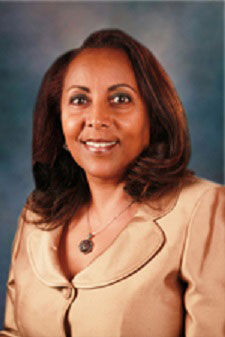


By Stanley O. Williford
Director of Publications
Tersit Asrat, then 17 years old, arrived in the U.S. from Addis Ababa, Ethiopia, as a student in 1972. Her parents had enrolled her in a Seventh-Day Adventist school in New Mexico.
But soon after beginning her studies, Tersit realized that she and the school were not on the same page.
"I didn’t like the school," said Tersit. "It was very strict."
She had friends in Riverside who had come to the U.S. earlier, so after roughly three weeks she left New Mexico and headed to Riverside to enroll at Rubidoux High. She graduated the following year.
Tersit said her parents understood the need to change. The Asrat family were not Adventists, but Coptics, or Coptic Orthodox Christians. The Coptic Church is one of the oldest churches in world, having been founded by the Apostle Mark in the first century during his travels in Egypt.
After high school, Tersit enrolled at Cal Poly Pomona where she studied marketing. It was there that she met Darryl White, the man who would soon become her husband.
Darryl found a job right out of college with an export-import company in Honolulu, Hawaii. The couple lived in the 50th state for four and a half years before relocating to Tucson, Arizona, where their son Kyros was born.
While visiting his brother in Houston, Darryl was killed in an automobile accident. Tersit, then 29, was left to raise her son alone.
Still unsure spiritually, Tersit had begun studying Hinduism. From there her search led her into a form of New Age spirituality. She believes the Lord allowed her to experience those religions so she wouldn’t have doubts about her Christian faith.
She began work with an advertising agency, but soon after started her own agency. God was calling her, not to advertising, but to broadcasting.
"The Lord gave me the vision immediately after I closed the advertising agency," she said. "I knew this guy in Washington, D.C., who had satellite radio channels. I was supposed to do some work for him after I closed my agency, and he offered me a radio channel."
"It was a call from God, so God gave me the vision to start it. But there were a lot of struggles with the satellite company. The owner was a Muslim guy. He was not opposed to me starting a Christian channel, but the people who were under him were not willing to work with me. I was in limbo. I didn’t know if I was supposed to do it.
"I believe it was spiritual warfare. The enemy didn’t want it to go forward. The Lord finally gave me a breakthrough, and the people who were opposing me were removed."
Hosanna Broadcasting Radio was born in 2007.
"When he gave me the vision for Hosanna," said Tersit, "the first thing I did was I seek the Lord. I wanted to know what He wanted me to do, but I didn’t have a real personal relationship with Him. My thinking was it was just another business, but when I heard the Lord say ’Christian channel’ I didn’t want to do it. I didn’t think I was worthy. It took me about eight months to move forward. I kind of left it alone for that time, but it just kept on coming back to me. People around me were telling me you have a call on your life."
For about eight years she had been attending Church of the Harvest (now Full Harvest International Church), led by Bishop Clarence McClendon. "I started to understand what it meant to have a personal relationship with the Lord. I learned so much from him. He used to have us fast every year at the beginning of the year. That’s when the vision became so clear that God had called me."
Hosanna Radio eventually took off, but it took seven years, she said. "We started airing in Middle East, Africa, Western Europe and India."
"A lot of people came to the Lord," she said, but getting support for the radio channel was difficult.
She credits Crenshaw Christian Center with helping her during that crucial time. She shared the vision with Apostle Frederick K.C. Price who told her to meet with Crenshaw CEO Angela Evans and her husband Vice President of Marketing Mike Evans. She said the church "stood with me and helped me a lot."
"The only support we got was from Crenshaw Christian Center," she said. "I’m always grateful to Crenshaw. What amazes me about Crenshaw is its commitment and dedication to missions."
Later support for Hosanna would come from Jack Hayford and George McKinney, but it was still a major struggle.
Due to lack of further support, the radio channel went off the air in 2010. In January in 2011, she launched satellite television in Southern California, and for a time relaunched radio only in Africa. But because of the financial strain could not continue radio. It was dropped again in 2014.
"I do the television as a way of raising money for radio," said Tersit. "But there is nothing you can do to raise money with radio unless you get pastoral support."
The television broadcast can be reached at www.hosannabroadcasting.com, but the dream is to beam into Africa, the Middle East, Western Europe and India.
The broadcast can be viewed at HBN-TV Directv 20, Dish Channel 20 and on AT&T UVERS Channel 3. For more information, log on to www.hosannabroadcasting.com
